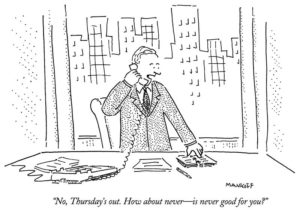 Bloom’s Blog
Bloom’s Blog
Welcome
Welcome to Bloom’s Blog. I have been a licensed clinical social worker for over 30 years. I am also a writer about all things related to well being: parenting dilemmas, work/life balance, women’s issues, sleeping disorders, coping with depression and anxiety, relational issues and managing the bully at work. This blog will hopefully become your “to go” place for information and answers around self-care as a means towards a positive sense of well being.
Stay tuned… I am currently compiling the “stack-up” list. A list of companies that not only do good for the world but also do well by their employees.
As the first time parent of twins I have struggled with many questions and I have searched high and low for answers. When the twins were young, I scanned the shelves of my local library and bookstore. I looked on the Internet. I spoke with friends and family members about a surprisingly elusive topic: What can I expect as a mother? How does it feel to be a parent? What should I plan for? Was parenting satisfying, not satisfying or did that even matter. Somehow, I felt selfish even asking these questions.
The sum and scope of the pages I read could be reduced to the following insights about parenting: that future parents most likely sat, pulled themselves up, and clapped their hands by the age of thirteen months; by fourteen months, most of these “busy” potential parents were able to wave bye-bye, stand alone and use the words “mama and dada.” By fifteen months the prospective parent was able to walk and say one word and by sixteen months they were able to imitate activities and scribble. This culminated in the twenty-eighth month when these amazing creatures were finally able to jump up, name six body parts and identify four pictures.
The books would then go on to explain techniques for a parent to contribute to their child’s development. Every book I read, every conversation I had, was a separate maze leading to this same place; winding its way back to the child’s developmental milestones. But what about the parent; somewhere in the pages of these books she or he seemed to get lost.
I spoke with my mother and listened while simultaneously feeling admonished “it’s not about you anymore, it’s about the children.” This seemed to presume the idea that by asking these questions I was being selfish and not considering my role as a parent. Mom also advised me to consult a book written by a Dr. Spock (possibly Vulcan?) and offered that spanking a child every once in a while was not a bad idea. I spoke with friends who had children and when asked they would alternately sigh, smile, laugh and comment that it was all just a blur. I noted the nervous laugh and tried to be positive, after all no one had mentioned crying, at least not on the part of the parent. I still felt left in the dark.
There seemed to be an assumption that at the end of this maze a parent’s effect on their children was the essence of being a parent; that as a mother I had, seemingly, been unaware that my body had blown up for nine months and had eventually shot out two watermelon sized children. Suddenly, I became invisible; my effect on my children was now paramount. I was like gravity or the wind, an intangible element that only could be measured by its effect on another human being. There also seemed to be a silent assumption that these efforts would culminate in a healthy well adjusted adult; which would then be my reward. I am still trying to figure it all out but now I have honed my resources and I have a better idea of where to turn for useful information. Hopefully this Blog will grow to be your place to turn to about all things having to do with well being.
by Laura Bloom, MSW, on July 17, 2017

“Over Scheduled”
How to cope with and manage
the bully at work

by Laura Bloom, MSW, on July 17, 2017
Soon after my 92 year old mother entered an assisted living facility I asked her how she liked it. She had one complaint “everybody here is so old; I don’t like old people.” Years later, at this same facility, all these old people keep to themselves and the only time they are unified, according to mom, is when they rush to the dining room for lunch. Which, arguably, is the best meal at this particular facility.
My mother’s statement, on the face of it seems counter intuitive, but in fact I think it maybe a common way of thinking. Like minded people may not share the same attributes or even, especially, the same set of circumstances. In other words, what if older people are ageist, women anti-feminist and minorities… anti-minority?
This way of thinking is more realistic and “intuitive” than one might think. People who seem to have a similar cause may not support one another; in fact people in the same pot may be just as inclined to claw at one another as to help lift one another out. Which then begs the question, who’s left to advocate for power minorities, if power minorities are unable to advocate for themselves?
Several of these same dynamics are at play with bullying.
When we think of bullying, children come to mind, but not all bullying happens on the playground; children mirror the adult world that surrounds them and if it’s happening on the playground, you can be sure it is also happening in the halls of the suburban corporate park.
I should now define bullying behaviors but I think people know what these are. We have all witnessed bullying, though we may not want to recognize it. I could cite statistics about the damaging effects that bullies have not only on their targets but also on the silent accomplices to the misery they cause. But people know that targeting a person or group with constant demeaning, intimidating or derogatory statements takes a toll. If you think that bullying is a made up phenomena by people who are weak or in some mysterious way are desirous of soliciting a rain of painful events down upon themselves, you really don’t need to read this article. You’ve already purchased your own protective umbrella.
Bullying is not logical, either. One might think, for example, that power minorities such as working women, are able to unite and support one another; yet they don’t. Over one third of working Americans say that they have been victimized by a bully and one fourth of Americans confide that they have witnessed scapegoating at work. Two out of every three people who tried to defend themselves against being targeted found that rather than helping them their defense triggered retaliation that went unnoticed. Ninety percent of these targets reported that their victimizer was an individual in a position of authority; women were most likely to be bullied. Their most frequent tormentor, other women. (Balcerzak,et al, 2015.) Research has also found that women in the workplace are most competitive with other women but tend to be the most cooperative when they work in groups with men; even surpassing their male colleagues ability to compromise, with other men. (Multiple authors, 2015.) Again, women, can compromise, just not with each other. Why would individuals, within a power minority, not support one another? As a member of this particular power minority I want to say that women are trained to be nurturing and to be sensitive to others, qualities that are essential for any society. My question is than, if women are so skilled at taking care of others, which they are, why can’t they take care of themselves?
Most women, 47%, gravitate to similar industries, careers that pay less than male dominated industries and that pay the women within these professions, the majority of the personnel, 20% less than their male colleagues. Because women gravitate to these same female dominated jobs that both pay less and pay women less, a child raised in a home in America that has a female head of the household has a 70% chance of being raised below the poverty level.(Peter Coy, Elizabeth Dwoskin, 2012 Elliott, Diana B. and Tavia Simmons, 2011. ) Factor in a divorce rate that continues to hover at around 50%; the chance that a life partner will protect a woman from economic ruin, especially should she find herself suddenly a single parent, becomes unlikely. So that, paradoxically, as women are socialized to compete primarily with each other for a partner; a woman’s lot in life may worsen if she depends on her partner’s economic livelihood to survive. In order to create a living wage for her family, especially if and when the primary breadwinner steps away from the family, she will need the support of social networks that help to not only make work more satisfying but that are also a necessity for getting, keeping and advancing at work; so that women, hopefully, don’t continue to lead the fastest growing group of families: those of female headed households with children, growing up in poverty.
Most people, when they discuss bullying, reduce the issue down to an individual personality trait or characteristic, with Narcissistic Personality Disorder being the most frequent bitter ingredient in this particular stew. But in my experience here’s how a bullying scenario is much more likely to go: An organization has a power hierarchy with an individual or group trying to jockey for power and move up the hierarchy. As they attempt to ascend they intimidate, threaten, demean, devalue or scapegoat their competition or subordinates, which may be an individual or even a whole department; in an attempt to intimidate others into giving them what they want (ie, to ascend the power hierarchy.) Bullying, therefore, is a product of social, economic and ultimately, power pyramids.
Bullies are cunning. If you are perceived as competition a bully will try to intimidate or scapegoat you; they follow the maxim of “kiss up and pee down,” so that if you are disinclined to notice their bad behavior, it is easy to avoid. What makes bullying very complicated to deal with is that bullies are masters at manipulating the “power” in any power hierarchy. They know that subordinates are bound to be silent, colleagues quiet, and superiors watchful. And there are work cultures that support bullying as a natural byproduct of competition. So that the bully doesn’t operate autonomously, both victim and bully are bound up within the expectations of their environment.
Why does the bully, bully? Because she or he can, and bullying works. Bullies more often than not, get their way. Yet all western European nations have laws in place that address bullying, except the United States. (Balcerzak, et al, 2015. )
Bullying is not simple but it’s solvable. Perhaps the first thing to realize is that you are not alone. Again, a large percent of U.S. employees (will admit) they have either been the target of bullying or witnessed it in their work lives.
Next, it’s not you. People don’t talk about the events surrounding being bullied. We are all taught as children to stay away from trouble. To not get mixed up into somebody else’s problems. People might worry that they may be blamed for their own misfortune, especially if it is someone with more seniority, or who is higher in rank, who is targeting them. They are worried that their bad luck will be used against them. The victim of rape will have to hear people wondering about her judgement: why was she jogging out there and at that time of night? She might have to embark on her next painful journey, wondering if she was the architect of her own misery.
It’s not you. Most likely, you just stepped into one of life’s awful sand traps; the ones no one discusses. Similar to the rat holes you find in dysfunctional families. Everyone knows about weird uncle Bob who groom’s special relationships with children, no one mentions him. Some moms have the wherewithal to keep Bob away from their children, others don’t. In adult life these human sand traps are not discussed. And therefore stepped into over and over again.
But there is hope. Business’ are starting to organize themselves differently so they can be more responsive to their customers and the ever changing world of technology. Because top down hierarchies are inefficient and slow, other organizational structures are evolving and within these alternative structures, lays hope.
I’m going to be focusing on bullying and I would like to hear from you: Do you have any strategies that are useful for managing a bully that you would like to share?
Please email your questions, stories and strategies to ConsideringU@mail.com.
References:
Judith Geneva Balcerzak, J, PhD, MSW, (2015). “Workplace bullying: Clinical and organizational perspectives.”NASW Press. Retrieved 11/16/16.
“Sex Differences in Cooperation: A Meta-Analytic Review of Social Dilemmas,” Daniel Balliet, PhD, Singapore Management University and VU University, the Netherlands; Norman P. Li, PhD, Singapore Management University; Shane J. MacFarlan, PhD, Washington State University; Mark Van Vugt, PhD, VU University, the Netherlands; Psychological Bulletin, Vol. 137, No. 6, February 25, 2010, Retrieved 11/16/16.
Peter Coy, Elizabeth Dwoskin, June 21, 2012. “Shortchanged: Why Women get paid less than Men.” Retrieved 11/16/16.
Elliott, Diana B. and Tavia Simmons. 2011. “Marital Events of Americans: 2009, American Community Survey
Reports,”ACS-13. U.S. Census Bureau, Washington, DC. Retrieved 11/16/16.
TOP STORIES
How to pick a
psychotherapist
by Laura Bloom, MSW, on July 17, 2017 Psychotherapy is a process that can help individuals, couples or groups when they are experiencing emotional distress. This emotional distress can be short term or long term but counseling is geared towards regaining your emotional equilibrium and feeling better regarding a particular issue or perhaps about life, in general. The goal is for you to feel that you have learned something, both emotionally and intellectually, that will allow you to feel “unstuck” in an area of your life that previously felt distressing or unsatisfying.
Psychotherapy is a process that can help individuals, couples or groups when they are experiencing emotional distress. This emotional distress can be short term or long term but counseling is geared towards regaining your emotional equilibrium and feeling better regarding a particular issue or perhaps about life, in general. The goal is for you to feel that you have learned something, both emotionally and intellectually, that will allow you to feel “unstuck” in an area of your life that previously felt distressing or unsatisfying.
A psychotherapist, which is a generic term, should be a state licensed professional. Licensing, though, varies from state-to-state so the professional names of psychotherapists may vary; but in most states mental health professionals are usually state licensed: Clinical Social Workers (LCSW), Professional Counselors (LPC), Marriage and Family Therapists (MFT), Clinical Psychologists (LCP) and Psychiatrists (MD). An individual may hold a degree, for example a MSW, or a MA, a PsyD or PhD, but may still not be a state licensed clinician. In addition to offering counseling services, when indicated, psychologists may provide psychological testing services and psychiatrists are able to prescribe psychotropic medications. There are also coaches of many types: career coaches, life coaches, business coaches. This is a relatively new field and these individuals are not regulated and can come from various disciplines, though finding a skilled coach is like digging for and finding that nugget of gold. A good coach is a cheerleader who can help guide you as you’re reaching for and achieving your desired goals.
Therapists, for various reasons, don’t tend to specialize in the same way medical professionals do. Though some people may have an area they have developed an expertise in, for example children and their families, men’s issues, women’s issues or work related stress, etc., many therapists tend to be generalists and work with multiple, overlapping issues.
If you have behavioral health insurance it can superficially make the decision of picking a psychotherapist easier. Just pick from their list of mental health providers or choose one of their employees who provide counseling services. Ahh, the plot thickens. In order to have your insurance company cover your counseling services you have to pick from a list of “empaneled” preferred providers. These lists may not be replenished very often and there may be therapists on the list who are accepting new clients but can not see you for awhile or the times they offer are inconvenient. Others may be located far, far away, in distant lands. Or as you start to call from this list you run into disconnected phone numbers, people who haven’t been taking on new clients for years, or perhaps they have recently retired. Another road block can be when a subscriber’s request for behavioral health services is referred back to a local social service agency.
A tale of two friends. I had one friend who was a licensed clinical psychologist with a private practice. The other worked for an advertising agency. Both suffered from panic attacks. Sondra who worked for the advertising agency went to a local not-for- profit organization that accepted her insurance. She received counseling services for around 3-6 months and then insurance started to balk about having to pay with Sondra and her therapist eventually terminating the therapy. Sondra usually felt better after these sessions but she still experienced panic attacks. Sondra is allowed a certain number of therapy sessions every year. Melissa, the psychologist, received a referral from a friend, also a psychologist, for a good clinician. She negotiated a competitive rate with this clinician that kicked in when her health insurance stopped paying and attended her therapy sessions every week for 2 years, when she stopped having panic attacks. Sondra subsequently has fallen into a pattern, over the last twenty-two years, of receiving short bursts of counseling every year and when insurance again begins to balk at payment, she stops her counseling; she then starts again with a new therapist and invariably a new insurance company at the beginning of the next year. Twenty-two years later Sondra is still experiencing panic attacks. She has had short term counseling over a long period of time, which has been ineffective. While Melissa had what is not usually offered by insurance companies, long term counseling services, which addressed the problem until she stopped requiring psychotherapy.This can be the conundrum of insurance; in the long run Melissa’s therapy cost less and Sondra’s cost more. Insurance, though, can be reluctant to pay for what is sees as too expensive: long term psychotherapy. Sondra’s situation can be a common occurrence, short term therapy over a long time, episodic therapy, without a remission of the presenting problem. Ideally, you want a good therapist who accepts your insurance and where you have a plan, perhaps a negotiated rate that you pay should insurance stop paying, and until they will pay again of how to see counseling through until your symptoms subside. Another choice, if health insurance is not an option, is to speak with your therapist about whether they offer a “sliding scale pay rate” based on ability to pay. When I was a psychotherapist in private practice, especially initially, I would adjust my fee based on a patient’s ability to pay.
The bad news is counseling may not work as quickly as everyone would like it to. The good news is, it can work
In mental health there can be a co-mingling of secular and nonsecular organizations and service providers. Non-secular counselors are generally not required to be state licensed in order to provide counseling services. An organization may be a private-for-profit or a not-for-profit organization that is a sub-contractor for a government funded mental health agency and not affiliated with a particular church, and may still be non-secular in nature. So that you want to be clear from the onset with a potential counselor as to whether you want a secular or a non-secular therapist and then expressly interview a potential therapist to explore their orientation.
State licensing, though, provides the assurance to the potential client of at least a minimum standard of competency. For this reason, I would strongly recommend the services of a state licensed professional. Many spiritual and/or religious counselors are, additionally, state licensed professional clinicians.
A fair amount of social service agencies utilize student interns who will be at that placement for a limited amount of time. These students should always be supervised by a licensed professional. The advantage in having a student is that you may end up with a relatively inexpensive, though naturally gifted psychotherapist; the disadvantage is that whether or not you are working well with the therapist, when the school year is over, you will need to either end the counseling or begin anew with your next psychotherapy intern.
A good therapist is trying to help in at least two ways: they are trying to impart information, tools, techniques or advice that is helpful. But as importantly, they are trying to create a “corrective emotional experience.” In other words they want you to have a better experience in the psychotherapy office then you may have previously had with a difficult boss, parent or coworker. So that you may get whatever emotional needs that life has thwarted met, acknowledged and accepted, and you may than continue to grow and flourish. This can all be heady stuff and with the advent of managed care and an emphasis on efficiency in counseling services some of these qualities have fallen by the wayside. These goals though are still important. I look for a therapist who will balance the information they give me with a counselor who is sensitive to my feelings and tries to work with me on having the world, or my place within it, feel better. The easiest way to find this is to look for a therapist who speaks less than you do in a session. In general I follow the ⅓ rule of thumb. You should in general be speaking for ⅔ of the session and your therapist should be speaking for ⅓ of the session, and be quiet and listening the rest of the time. This is your time to talk, grow and expand. You need to have your time to try out and practice new feelings and behaviors in the small world of your therapist’s office before you are able to operate this same way beyond the confines of the clinical setting. So well rounded therapy not only consists of an intellectual, teaching or didactic quality but also consists of an interpersonal or relational component, where the client can safely examine themselves and test out new feelings and behaviors that will allow them to grow and come into their own as a healthy, happy adult.
People who do not receive counseling services may eventually find their emotional equilibrium, but those who receive counseling services can heal much quicker. There can also be a myriad of dynamics that combine to keep people who are in emotional distress isolated. One can tough things out alone but sometimes that in itself can be a brutal and damaging process. This is your time to rely on supportive people and that’s o.k. Your job is to find an empathic, knowledgeable professional and then to commit to the therapeutic process. You can then use this time to heal yourself, so that you can get back to where you were before or better yet, begin your journey once again, renewed

Parenting, a cautionary tale:
by Laura Bloom, MSW, on July 17, 2017
What causes poverty? Is it growing up poor? How about growing up as part of an ethnic or power minority? Perhaps lack of access to an education? I am currently, simultaneously, typing on my computer while watching TV commercials: there’s a happy mother vacuuming as her children, husband and dog leave a trail of crumbs behind on the carpet. There’s a fussy mom choosing peanut butter and another dad taking pictures of a happy mom and child and then transferring his pictures to his computer. Most households, I must than conclude, consist of bright happy families, a dad, mom and two children, who gratefully consume products and services. Except that two parent families are in decline and are now a minority. Most households, fifty seven percent, consist of only one or two adults. Households with children, although a minority at forty-three percent, do consist of a growing segment of the population: poor mothers and their children.
Once upon a time my dreams came true. I was married. I still am. The day of my wedding was magical. White dress, bridesmaids, my husband by my side, friends and family in attendance. I wanted my wedding to formalize this new stage in my life, to introduce a new “us” to family and friends. Suddenly, though, a formerly silent world opened up in front of me. A bed room scattered with Ken and Barbie dolls, easy bake ovens, and dolls that you fed, changed and pulled on a string, on their back, only to hear them repeat the word “mama” over and over again.
I remember playing mommy and daddy with my best friend Debbie: I would serve her a hearty breakfast made in the miniature replica of a kitchen that we both had, toast it up nice and (very) brown in my ever present oven and serve it up to her as she would prepare to walk out the door, on her way to work. “Have a nice day” I would intone. I would then industriously begin to prepare dinner in anticipation of my ‘husband’s” arrival home from work. I must admit though that soon into breakfast this game would end as Debbie and I would veer our attention off into the next game. We also practiced being brides, choosing our bridal dresses, shoes and menus for that all important day. And now, as I looked out on the filled banquet hall I could feel myself suddenly shrinking back into that 10 year old little girl, standing in her mother’s white heels and dress. Suddenly, long silent childhood hopes and dreams began to take over.
I wanted to be a beautiful bride, carried away in a horse drawn carriage to live happily ever after. The day had to be perfect. As it got closer to the wedding date I began to feel like a “wedding mole.” Somebody who, when pressed into service, had become someone else. A cold war bridal operative who suddenly expected, on her wedding day, that the pumpkins would turn into a carriage and the mice would suddenly morph into horses. What would happen next? Would I break out into song, perhaps something about finding my prince? At least I had won the argument with my mom; the wedding reception would have an open bar.
And they all lived happily after. Here’s where I think fantasy and reality may drastically part ways. The marriage fantasy can change dramatically after children. This road may not only be a rite of passage for women; it can lead to an uncertain future for a woman and her children. As the life expectancy of most marriages hovers at around a 50% and women, after a divorce, tend to retain physical custody of the couple’s children some statistics begin to emerge:
Women are paid around 22% less than men for the same work. Women tend to find their way to lower paying fields such as jobs in social work and education. 1 Out of the minority of forty-three percent of households that still have children present in the home, a majority of these are single parent, female headed households. Seventy three percent of these households live at or below the poverty level 2; so that a majority of children who live in female headed households are growing up, living in poverty.
Perhaps happily ever after is a fantasy, but for a woman and her children, it may not only be the end of an illusion, it may also be the beginning of her downfall.
References:
1. Peter Coy, Elizabeth Dwoskin, June 21, 2012. Shortchanged: Why Women get paid less than Men.
2. Elliott, Diana B. and Tavia Simmons. 2011. Marital Events of Americans: 2009, American Community Survey Reports, ACS-13. U.S. Census Bureau, Washington, DC.

Excerpt from my new book:
When Work is Hell
How to Deal with a Bully at Work.
Foreward:
“Your enemies can kill you, but only your friends can hurt you.
Freedom is participation in power.”
-Marcus Cicero
Once upon a long, long, time ago, I was a social work intern. A professor assigned my class the task of sitting in on a Board meeting at the organization that each student was doing his or her internship at. My internship was at a large suburban hospital. Two questions immediately popped into my little intern brain: what is a Board meeting and how could I wrangle an invitation to one. My grade was riding on it and if you did not keep your grade up at this particular graduate school you risked being expelled. I spoke with fellow students but they were also fuzzy on the whole Board meeting concept. I asked my supervisor who did not know the answer to my question so then I asked some other people at the hospital, to no avail. Soon after I was called into the office of not my supervisor, not her supervisor, not his supervisor, but his supervisor’s supervisor, a man I had not known existed. He offered me a stern thirty minute lecture on “knowing my place.” I walked out of his office knowing one thing for sure. I was not going to get an invitation to that Board meeting. I spoke with my professor and she offered an agency whose meeting I could attend. Problem solved. I am, though, embarrassed to admit that over thirty years later I still struggle with the whole concept of “knowing my place.”
This book is my continued effort to sort out this issue. As a consequence, I am not writing from the objective, perhaps safer and wiser, clinical third person perspective. This book is about surviving in the work world, psyche intact. A need that remains universal, yet continues to be invisible. The stressful, dehumanizing factors at work are not just caused by the way people treat one another but also by the way organizations or groups of individuals, combined, treat one another.
Most people just want to feel significant in life and work but dysfunctional systems are organized in a way as to create the most amount of misery for the least amount of productivity.
This book’s central premise is that human beings, like other primates, strive to create hierarchies in life. Workplace bullying is primarily structural in nature and this structure can be manipulated by bullies. Therefore, an understanding of the structure of work is vital for negotiating and surviving the world of work.
I think people are more socially pliable than they like to admit and certain circumstances and environments can foster and highlight certain aspects of human behavior. This book is about how organizations, or collectives of individuals, operate. It is not meant to be a commentary about intrapsychic dynamics as much as an examination of how organizations affect the people who function within them and the reciprocity that can exist between the dysfunctional aspects of ourselves and the broken systems we are a part of.
So much human misery is caused by work. This book comes from a bad day at work in hopes that others can avoid these landmines and survive the work world, psyche intact.
Chapter 1 the Foundation.
“Nearly all men can stand adversity, but if you want to test a man’s character, give him power”
Abraham Lincoln
Why does a spouse strike their partner? Why don’t the victims in these relationships just leave? What makes them stay? What are the dynamics of abuse and do these dynamics transfer to other, less intimate, situations? Understanding these questions may offer useful insights into the actions that help to keep victims silently pinned to their page, a perpetrator unaccountable for their actions, and the witnesses to their destructive dance, silent.
There’s a similar type of violence that also thrives in silence so successfully that it is almost impossible to recognize yet nearly one third of working Americans say that they have been victimized by it and one fourth of Americans confide that they have witnessed it. Two out of every three people who tried to defend themselves against it found that rather than helping them their defense triggered retaliation that went unnoticed. Ninety percent of these “targets” reported that their victimizer was an individual in a position of authority, women were more likely to be targets, and most people who were scapegoated were of a similar sex as their victimizer.1
I am talking about aggression in the school and workplace settings in the form of bullying and “mobbing” behaviors, which left unchecked may escalate to physical acts of aggression or even suicide.
Bullying according to Dr. Balcerzak a psychologist and social worker who writes about abuse in the workplace “focuses on the actions of a single person.” Bullying behaviors, may include “insulting comments about a person’s private life or background, humiliating or intimidating behaviors, rumors or false allegations, and exclusion from customary workplace socialization.” Mobbing has been defined as “hostile and unethical communication directed in a systematic way, by one or more people toward another person or group, occurring often (almost daily) over a long period of time, generally for at least six months. This early description of the syndrome suggests that mobbing behavior “involves ganging up on a targeted employee and subjecting that person to severe, emotionally damaging harassment.” (Balcerzak J, et al, 2015)2 Mobbing is done by more than one person and can include “an institutional or systemic process in which many of those in administrative authority are involved in trying to force an employee out of the workplace via over direction and over documentation. In such instances, administration even supports the original perpetrator because this serves a function for the organization. ” (Balcerzak J, et al, 2015) 3
The Military- speaking truth to power:
Work is predicated on how the military is organized, to conduct war, as the military was the first organized work environment. And subsequently it has become the model for most work environments. Over time, this hierarchical model has evolved into an inefficient and unresponsive work pyramid that does not focus on client or employee engagement; yet even today most of us still work within the rigid, slow to change and highly exploitable confines of a an organizational pyramid.
I’m going to also speak about the military a lot because this is the prototype of a pyramid organizational hierarchy. This organizational style may be workable for the military but it doesn’t transfer over to other industrious that have a different mission. When I talk about the actions of the military I am not commentating upon the individuals within it; I am speaking about how the military is organized to accomplish tasks as a whole, or as a system.
A bureaucracy may be governmental or corporate. The strengths of a bureaucracy are that they are resistant to change and maintain the status quo, they can also be blind to individual strengths and weaknesses. A bureaucracies weakness’ are the flip side of their strengths, they do not adapt well to changing industries and fluid customer needs and are not structured to harness an employee’s particular strengths. Communication only happens from the top down and not the reverse. The most rigidly defined bureaucracy lives in the military, next in the public sector or government, after that in private not for profit organizations and lastly in private for profit organizations, in a business or a company.
This book is about change. There are a fair amount of books out there that talk about how change happens individually, which is important, but I believe incomplete. I want to discuss how we can effect change not only within ourselves but also outside of ourselves, in our work environment. This does not mean throwing out the baby with the bathwater and getting rid of bureaucracies; it means improving them so that they support the flow of work within the organization, instead of impeding it.
Anna
Anna is a registered nurse at a large County mental health organization. She is a single parent of three young girls and as a consequence is vigilant about her career. She was next up for promotion on the civil service list that management must use to fill a position. The promotion went to someone else. Soon after another promotional position opened up much closer to her home. Anna applied for this job and met all of the criteria for this position and again management was required to hire off the lists that human resources created unless management could prove that the required skill set did not exist within any of the candidates. Management filled this job with another worker who did not have unique skills though there were rumors she was a friend of her supervisor. Anna spoke with the union and received the next promotional position that became available. But then peculiar things soon began to happen; from getting good annual performance evaluations now seemingly Anna could not do anything right. Every time she returned to her desk there was a memo waiting for her, accusing her of being “derelict in her duties.” It got so bad that Anna now required colleagues who were “bathroom monitors” who were willing to corroborate every time Anna used the facilities, so that she would not be accused of “abandoning her post.” Anna was not allowed to leave the confines of the office, even though her clients existed in the community and she was required, as part of her job, to make home visits. Subsequently, her job performance was brought into question because her productivity numbers began to fall as she was unable to meet with her clients in the community. Both Anna, and her supervisors days, began to be filled with accusations, grievances and counter grievances with no end in sight. Because Anna was represented by a union her case went to a county arbitrator who was unable to render a decision. To this day, Anna and her employer have flare ups which can consume days, weeks and months of time.
Perhaps one could just say that employers should, as a part of their power, have the ability to hire and fire who they want to and when they want to, thereby ridding themselves of any employee who falls out of favor. Most business do have this power and utilize it freely. The average worker now stays in their position for around five years with business’ freely churning through employees.
To keep on reading please contact the E-mail listed below.
Copyright 2017 by Laura Bloom, MSW
References
Chapter one
1 Balcerzak, Judith Geneva., PhD, MSW, Workplace Bullying Clinical and Organizational Perspectives. Washington, DC: NASW, National Association of Social Workers, 2015.
2 Balcerzak, Judith, G, et al, 2015.
3 John Grohl, PsyD. “15 Common Defense Mechanisms.” Psych Central, 17 July 2016. Web. 25 June 2017.
4 Balcerzak, Judith, G, et al, 2015.
5 Cherry, Kendra. “What Are Piaget’s Four Stages of Development?” Very well. N.p., n.d. Web. 25 June 2017. http://psychology.about.com/od/piagetstheory/a/keyconcepts.htm.
6 Balcerzak Judith, G, et al, 2015.
7 DeSilver, Drew. “U.S. Income Inequality, on Rise for Decades, Is Now Highest since 1928.” Pew Research Center, 05 Dec. 2013. Web. 25 June 2017. http://www.pewresearch.org/fact-tank/2013/12/05/u-s-income-inequality-on-rise-for-decades-is-now-highest-since-1928/.
8 Altschul,Terri. “The Single Question That Is Changing the Way I Plan and Set Goals.” The Huffington Post. TheHuffingtonPost.com, 14 Dec. 2016. Web. 25 June 2017.
9 Morgan, Jacob. “The 14 Principles Of The Future Organization.” Forbes. Forbes Magazine, 16 Jan. 2015. Web. 25 June 2017.
10 Balcerzak Judith, G, et al, 2015.
11″10 Psychological Keys to Job Satisfaction.” PsyBlog. N.p., 07 July 2013. Web. 25 June 2017.
12 DeSilver, Drew. “U.S. Trails Most Developed Countries in Voter Turnout.” Pew Research Center. Pew Research Center, 15 May 2017. Web. 25 June 2017.
13 Turner, Cory. “Teachers Are Stressed, And That Should Stress Us All.” NPR. NPR, 30 Dec. 2016. Web. 25 June 2017.

Jacob age 6
http://blog.consideringu.com
Laura Bloom, MSW
Roseville, California, U. S. A.
(916) 251-9301
Last updated 7/20/17 by Laura Bloom, MSW
